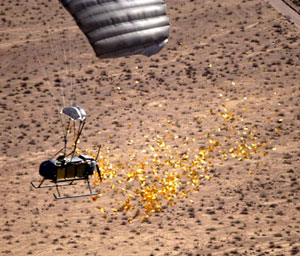The US Special Operations Command is looking to transfer its fleet of Mist Mobility Integrated Systems Technology (MMIST) CQ-10 Snow Goose unmanned logistics air vehicles to another service after proving the military utility of the type in Afghanistan and Iraq.
The transfer decision has been driven by competing mission requirements within SOCOM, says chairman of the MMIST board of directors Ronald Campbell.
SOCOM "has a lot of things they need to balance" he has told Flight Unmanned. "They are actively helping us source another user within the USA".
That process is likely to be rapid he says.
MMIST was notified of SOCOM's decision to seek a new home for the ULAV in the May-June timeframe this year.

Snow Goose development was funded by SOCOM to support psychological operations requirements with approvals for initial low-rate production given in June 2003. Full rate production approvals for up to 200 aircraft over a five-year period were given in August 2004, with 28 aircraft delivered as at May this year.
The type was first operationally deployed last year. "We successfully deployed to Afghanistan we successfully deployed in Iraq," says Campbell. "We are receiving nothing but high-level praise and commendations for the product. We know it works and we have strong user support."
Lessons from operational use of the system are also being spiralled into MMIST plans for a second generation Snow Goose, with this likely to incorporate a self-deployment capability.
MMIST is working on an autogyro style wing for the ULAV, Campbell says, with this able to be alternated with the existing parasail system. The new version is likely to be released on to the market in around 18 months.
The new configuration would allow for a parasail equipped Snow Goose to be air-launched as part of a special forces insertion mission, carrying a sensor suite and mission spares, as well as the optional autogyro-wing.
On landing the parasail could be removed and the autogyro wing attached, with the aircraft then re-launched to take up station above the detachment providing visual sensor surveillance and intelligence data.
The existing parasail based version can be ground launched, but needs to be fitted to a vehicle such as a HMMWV to be brought up to flight speed.
MMIST are also planning to package and market the existing Snow Goose air vehicle as a surveillance and reconnaissance asset. Previous marketing efforts have focused on the platform alone, says Campbell. However, the company is now developing a variety of customer ready mission configurations which leverage the 18h endurance of the aircraft.
In parallel MMIST is working on development of a civil marketplace for the ULAV as part of its newly established Precision Aerial Delivery Services company. That entity will offer both Snow Goose and MMIST's Sherpa guided parachute delivery system as a commercial service, with this targeting users in the resources industry as well as emergency relief agencies.
An immediate target will be oil and gas camps in Canada's far north. These are almost totally dependent on air support, says Campbell, but with manned aviation heavily restricted by weather. Snow Goose and Sherpa should be able to operate in a wide range of conditions he says, significantly expanding the level of logistics support available to those operations.
Source: Flight International




















